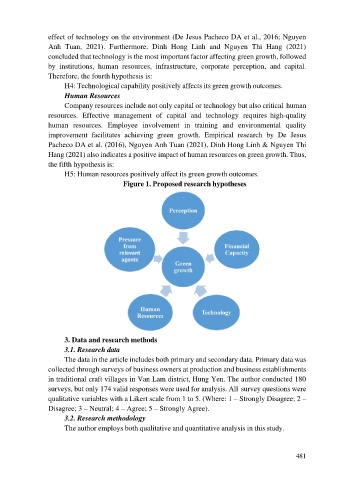Page 489 - Ebook HTKH 2024
P. 489
effect of technology on the environment (De Jesus Pacheco DA et al., 2016; Nguyen
Anh Tuan, 2021). Furthermore, Dinh Hong Linh and Nguyen Thi Hang (2021)
concluded that technology is the most important factor affecting green growth, followed
by institutions, human resources, infrastructure, corporate perception, and capital.
Therefore, the fourth hypothesis is:
H4: Technological capability positively affects its green growth outcomes.
Human Resources
Company resources include not only capital or technology but also critical human
resources. Effective management of capital and technology requires high-quality
human resources. Employee involvement in training and environmental quality
improvement facilitates achieving green growth. Empirical research by De Jesus
Pacheco DA et al. (2016), Nguyen Anh Tuan (2021), Dinh Hong Linh & Nguyen Thi
Hang (2021) also indicates a positive impact of human resources on green growth. Thus,
the fifth hypothesis is:
H5: Human resources positively affect its green growth outcomes.
Figure 1. Proposed research hypotheses
3. Data and research methods
3.1. Research data
The data in the article includes both primary and secondary data. Primary data was
collected through surveys of business owners at production and business establishments
in traditional craft villages in Van Lam district, Hung Yen. The author conducted 180
surveys, but only 174 valid responses were used for analysis. All survey questions were
qualitative variables with a Likert scale from 1 to 5. (Where: 1 – Strongly Disagree; 2 –
Disagree; 3 – Neutral; 4 – Agree; 5 – Strongly Agree).
3.2. Research methodology
The author employs both qualitative and quantitative analysis in this study.
481

